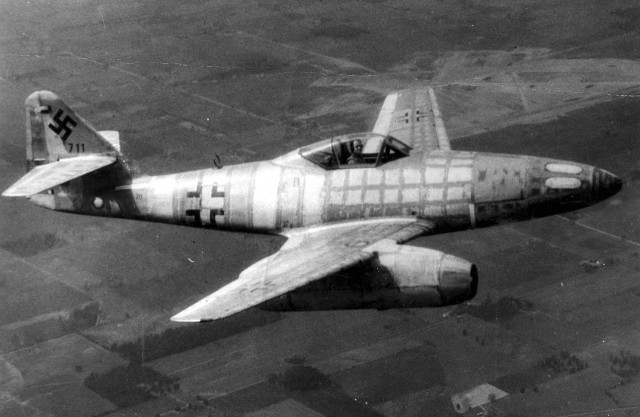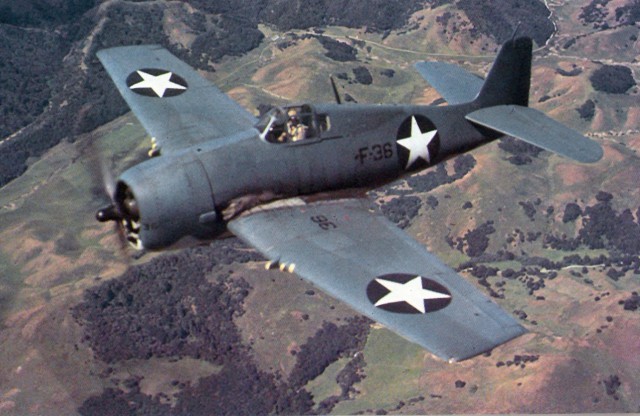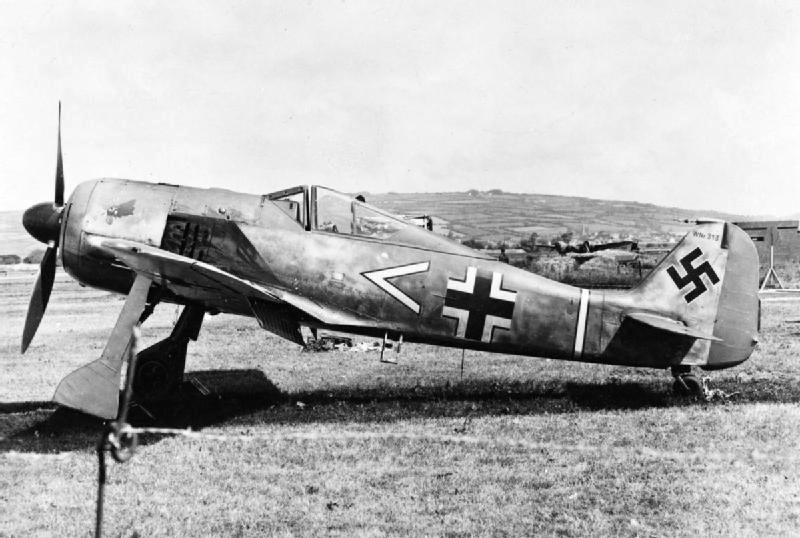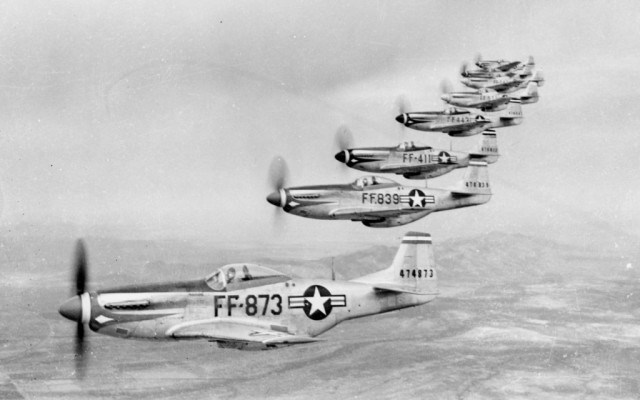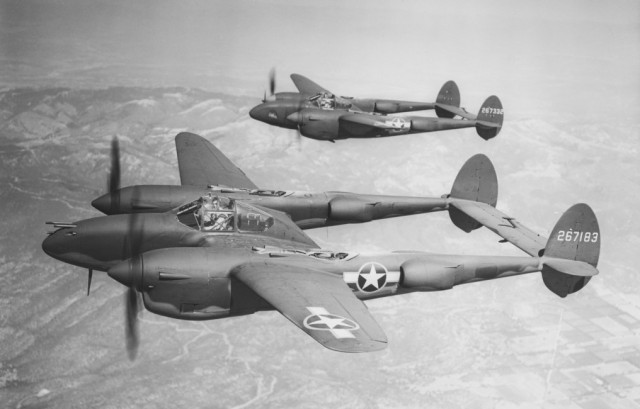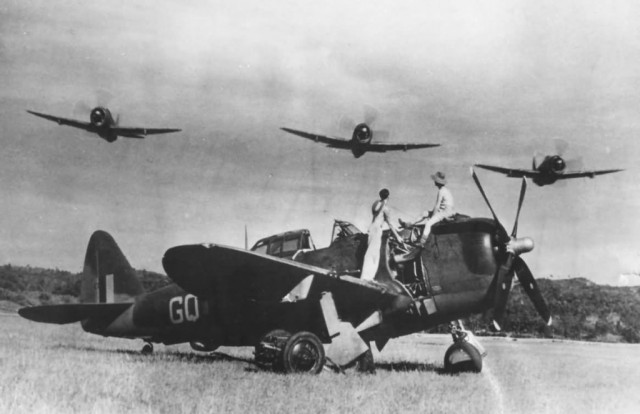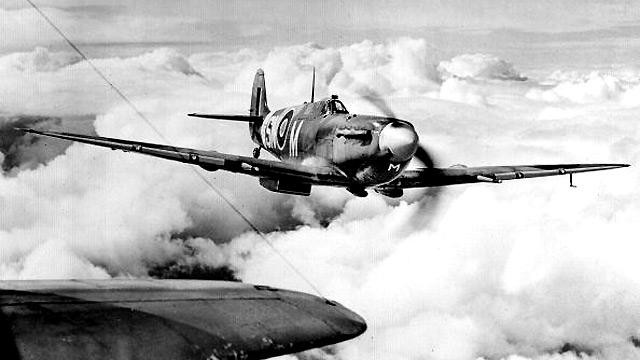Ten of the best fighters of WWII??
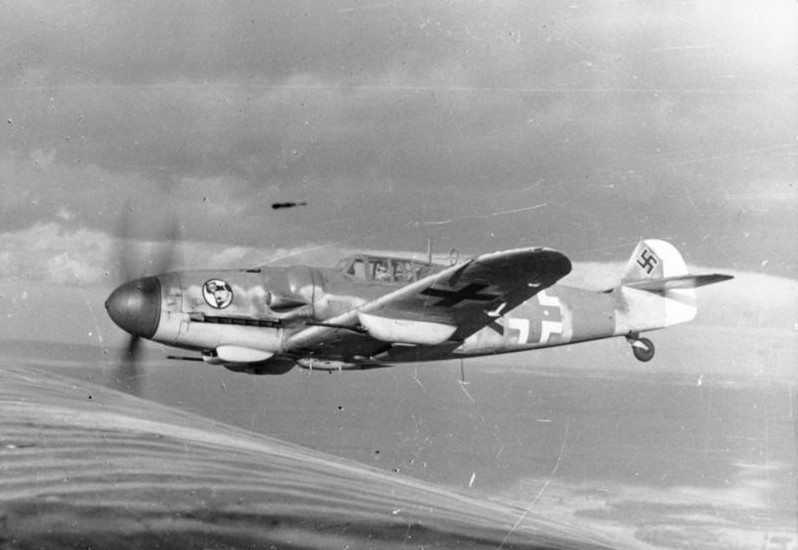
Over a period of six years of conflict, from 1939 to 1945, aircraft designs had progressed in leaps and bounds. From the obsolete biplane, to the world’s first jet fighter, from crude two-engined bombers, to radical designs of the B-29 Superfortress heavy bombers, World War Two had seen the most radical use of aircraft in the battlefield.
Here are ten of the best!
Soviet Yakovlev Yak-3
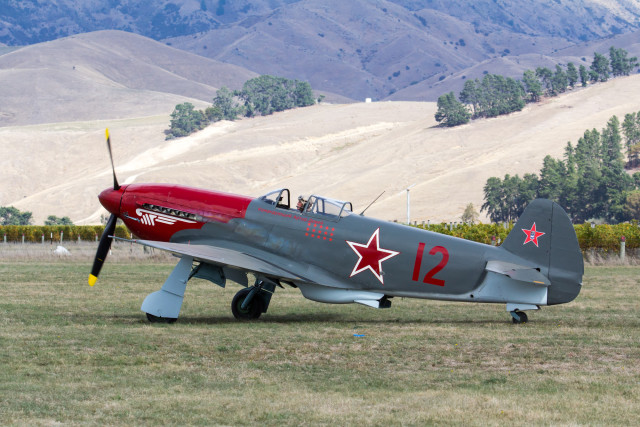
In the end it was the opinion of pilots that mattered. When the German pilots were told to “avoid combat below five thousand metres with Yakovlev fighters lacking an oil cooler intake beneath the nose”, it is obvious the Germans were terrified of this plane.
The Yakovlev Yak-3 was a World War II Soviet fighter aircraft. Robust and easy to maintain, it was much liked by pilots and ground crew alike. It was one of the smallest and lightest major combat fighters fielded by any combatant during the war, and its high power-to-weight ratio gave it excellent performance. It proved a formidable dogfighter. Marcel Albert, World War II French ace, who flew the Yak in USSR with the Normandie-Niémen Group, considered it a superior aircraft to the P-51D Mustang and the Supermarine Spitfire. After the war ended, it flew with the Yugoslav and Polish Air Forces.
Messerschmitt Me 262
An operational jet-powered fighter aircraft. Design work started before World War II began, but engine problems and top-level interference kept the aircraft from operational status with the Luftwaffe until mid-1944. Heavily armed, it was faster than any Allied fighter, including the British jet-powered Gloster Meteor. One of the most advanced aviation designs in operational use. During World War II, the Me 262 was used in a variety of roles, including light bomber, reconnaissance, and even experimental night fighter versions.
Me 262 pilots claimed a total of 542 Allied kills, although higher claims are sometimes made. The Allies countered its potential effectiveness in the air by attacking the aircraft on the ground and during takeoff and landing. Engine reliability problems, from the pioneering nature of its Junkers Jumo 004 axial-flow turbojet engines—the first ever placed in mass production—and attacks by Allied forces on fuel supplies during the deteriorating late-war situation also reduced the effectiveness of the aircraft as a fighting force. In the end, the Me 262 had a negligible impact on the course of the war as a result of its late introduction and the consequently small numbers put in operational service.
Grumman F6F Hellcat
This is the plane that took the US to the gates of Tokyo. You have to look at the rate of climb of the F8 Bearcat!
The Hellcat was an erstwhile rival of the faster Vought F4U Corsair for use as a carrier-based fighter. However, the Corsair had significant issues with carrier landing that the Hellcat did not, allowing the Hellcat to become the Navy’s dominant fighter in the second part of World War II, a position the Hellcat did not relinquish. The Corsair instead was primarily deployed to great effect in land-based use by the U.S. Marine Corps.
Although the F6F resembled the Wildcat in some ways, it was a completely new design, powered by a 2,000 hp Pratt & Whitney R-2800, the same powerplant used for both the Corsair and the United States Army Air Force’s (USAAF) Republic P-47 Thunderbolt fighters. Some military observers tagged the Hellcat as the “Wildcat’s big brother”.
The F6F was best known for its role as a rugged, well-designed carrier fighter which was able, after its combat debut in early 1943, to counter the Mitsubishi A6M Zero and help secure air superiority over the Pacific Theater. Such was the quality of the basic simple, straightforward design, that the Hellcat was the least modified fighter of the war, with a total of 12,200 being built in just over two years.
Hellcats were credited with destroying 5,223 aircraft while in service with the U.S. Navy, U.S. Marine Corps, and the Royal Navy’s Fleet Air Arm. This was more than any other Allied naval aircraft. Postwar, the Hellcat was phased out of frontline service but remained in service as late as 1954 as a night fighter.
Focke-Wulf Fw-190
One of the best fighters of all time, no Allied pilot who fought in the skies of Europe will forget the feats of the Fw-190. Introduced in September 1941, this fighter shocked RAF pilots and inflicted cruel punishment on Allied bombers flying over Europe. Highly respected by Allied pilots, the Fw-190 was a superb fighter, fighter-bomber, and anti-tank aircraft. Oberleutnant Otto Kittel scored most of his 267 kills in a Fw-190, forever immortalizing him as the fourth top scoring ace of the Luftwaffe.
The Focke-Wulf Fw 190 Würger (English: Shrike) is a German single-seat, single-engine fighter aircraft designed by Kurt Tank in the late 1930s and widely used during World War II. Along with its well-known counterpart, the Messerschmitt Bf 109, the Fw 190 became the backbone of the Luftwaffe’s Jagdwaffe (Fighter Force). The twin-row BMW 801 radial engine that powered most operational versions enabled the Fw 190 to lift larger loads than the Bf 109, allowing its use as a day fighter, fighter-bomber, ground-attack aircraft and, to a lesser degree, night fighter.
Messerschmitt Bf 109
Aviation history describes the Bf-109 as one of the greatest fighters in history. When first introduced, this fearsome aircraft was among the best of its day, putting it in the same league as the British Spitfire. Fast and graceful, Bf-109s ruled the skies at high altitudes, but as bomber escorts over Great Britain, these high flyers had to pitch their battles at low altitudes – a task it was ill-suited to perform. Nevertheless, the Bf-109 with its heavy punch of 20mm cannons would go on to become the most important fighter in the Luftwaffe, serving on all fronts of the war.
The Messerschmitt Bf 109, sometimes incorrectly called the Me 109 (most often by Allied pilots and aircrew), is a German World War II fighter aircraft designed by Willy Messerschmitt and Robert Lusser during the early to mid-1930s. The “Bf 109” designation was issued by the German ministry of aviation and represents the developing company Bayerische Flugzeugwerke (at which the engineer Messerschmitt led the development of the plane) and a rather arbitrary figure. It was one of the first truly modern fighters of the era, including such features as all-metal monocoque construction, a closed canopy, and retractable landing gear. It was powered by a liquid-cooled, inverted-V12 aero engine.
The Bf 109 first saw operational service during the Spanish Civil War and was still in service at the dawn of the jet age at the end of World War II, during which time it was the backbone of the Luftwaffe’s fighter force. From the end of 1941, the Bf 109 was steadily being supplemented by the superior Focke-Wulf Fw 190.
Originally conceived as an interceptor, later models were developed to fulfill multiple tasks, serving as bomber escort, fighter-bomber, day-, night-, all-weather fighter, ground-attack aircraft, and as reconnaissance aircraft. It was supplied to and operated by several states during World War II, and served with several countries for many years after the war. The Bf 109 was the most produced fighter aircraft in history, with a total of 33,984 airframes produced from 1936 up to April 1945.
P-51 Mustang
When introduced in larger numbers in early 1944, the Merlin engined Mustangs brought about a huge change in the daylight air offensive against Germany. For the first time, the Allies had a fast, maneuverable, high altitude single engined fighter, that could escort their heavy bombers to anywhere in Germany.
This is what sets Merlin engined Mustangs apart from all other WWII fighters, others may have had similar performance, the Spitfire, the FW190D9, (The ME262 was a hundred mph faster) but none of these had the extreme range of the Mustang (except some early Japanese fighters which weren’t even close to the Mustang in performance), which made the Mustang an offensive strategic fighter unlike the others. The P-51 was just like icing on the cake, with slightly better performance, range, and a bubble canopy. It literally changed the nature of strategic air warfare.
As Allied armies fought their way deep into occupied Europe, it was the P-51 Mustang which wrested control of the skies from the Luftwaffe. More than just a ferocious dogfighter, the P-51 Mustang was one of the fastest piston-engined fighters and could fly higher and go further than any other combat aircraft of the war. The P-51 Mustang claimed the most Allied kills with no fewer than 281 pilots earning the “Aces” (5 kills) distinction in a Mustang.
P-38 Lightning
Great range and firepower, two powerful turbocharged engines and the best aerodynamics of any warplane make this plane a top choice. The kill ratio here is one of the very best. Limited only by altitude its superiority in the pacific was obvious.
The P-38 had distinctive twin booms and a single, central nacelle containing the cockpit and armament. Named “fork-tailed devil” by the Luftwaffe and “two planes, one pilot” by the Japanese.The P-38 was used in a number of roles, including interception, dive bombing, level bombing, ground-attack, night fighting, photo reconnaissance, radar and visual pathfinding for bombers, and evacuation missions, and extensively as a long-range escort fighter when equipped with drop tanks under its wings.
The P-38 was used most successfully in the Pacific Theater of Operations and the China-Burma-India Theater of Operations as the aircraft of America’s top aces, Richard Bong (40 victories), Thomas McGuire (38 victories) and Charles H. MacDonald (36 victories). In the South West Pacific theater, the P-38 was the primary long-range fighter of United States Army Air Forces until the appearance of large numbers of P-51D Mustangs toward the end of the war
P-47 Thunderbolt
The Republic P-47 Thunderbolt is one of the largest and heaviest fighter aircraft in history to be powered by a single piston engine. It was built from 1941-1945. It was heavily armed with eight .50-calibre machine guns, four per wing. When fully loaded, the P-47 weighed up to eight tons, and in the fighter-bomber ground-attack roles could carry five-inch rockets or a significant bomb load of 2,500 pounds; it could carry more than half the payload of the B-17 bomber on long-range missions (although the B-17 had a far greater range).The P-47 shot down more German fighters than the P-51 (570 out of 873), and shot down approximately 900 of the 1,983 claimed during the first six months of 1944. In Europe, Thunderbolts flew more sorties (423,435) than P-51s, P-38s and P-40s combined.
The P-47 was one of the main United States Army Air Forces (USAAF) fighters of World War II, and served with other Allied air forces, notably those of France, Britain, and Russia. Mexican and Brazilian squadrons fighting alongside the U.S. were equipped with the P-47.
The armored cockpit was roomy inside, comfortable for the pilot, and offered good visibility. A modern-day U.S. ground-attack aircraft, the Fairchild Republic A-10 Thunderbolt II, takes its name from the P-47. Orders for an additional 5,934 were canceled when the war ended.
Spitfire
The Supermarine Spitfire is possibly the most famous combat aircraft in history. Champions of low-level duels, Spitfires earned their immortality as the fighter that turned the tide in the Battle of Britain. Against its greatest foe, the Messerschmitt Bf-109, Spitfires forced the German fighter to stay low to protect the bombers – negating the Bf-109s’ advantages while multiplying its own.
The Spitfire achieved legendary status during the Battle of Britain by achieving the highest victory-to-loss ratio among British aircraft. Spitfires were flown by British aces Johnnie Johnson (34 kills), Douglas Bader (20 kills), and Bob Tuck (27 kills). The Spitfire was produced in greater numbers than any other British aircraft and was the only British fighter to be in continuous production throughout the war
Mitsubishi Zero
When it was introduced early in World War II, the Zero was considered the most capable carrier-based fighter in the world, combining excellent maneuverability and very long range. In early combat operations, the Zero gained a legendary reputation as a dogfighter, achieving the outstanding kill ratio of 12 to 1, but by mid-1942 a combination of new tactics and the introduction of better equipment enabled the Allied pilots to engage the Zero on generally equal terms.
The Imperial Japanese Navy Air Service (“IJNAS”) also frequently used the type as a land-based fighter. By 1943, inherent design weaknesses and the failure to develop more powerful aircraft engines meant that the Zero became less effective against newer enemy fighters, which possessed greater firepower, armor, and speed, and approached the Zero’s maneuverability. Although the Mitsubishi A6M was outdated by 1944, design delays and production difficulties of newer Japanese aircraft types meant that it continued to serve in a front line role until the end of the war. During the final years of the War in the Pacific, the Zero was also adapted for use in kamikaze operations. During the course of the war, Japan produced more Zeros than any other model of combat aircraft
